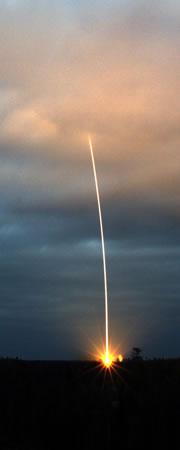 Lift off: CryoSat took off to a glorious view, but crashed soon afterwards.© ESA
Lift off: CryoSat took off to a glorious view, but crashed soon afterwards.© ESAA European Space Agency satellite that was designed to measure receding ice at the Earth's poles was destroyed shortly after it launched on 8 October, due to an unusual launch rocket malfunction.
Scientists hoped that CryoSat, which cost €135 million (US$160 million), would be able to measure the thickness of polar ice to within a few centimetres. This would give scientists their first three-dimensional view of the extent of ice loss at the poles. But two hours after the launch from the Plesetsk spaceport in northern Russia, mission controllers had failed to make scheduled contact with the probe.
A first look at data from the flight has revealed that the fault occurred because of a missing computer command in the onboard launch system. The main engines in the second section of the three-stage rocket continued to burn until they had completely run out of fuel, rather than cutting out so that the third stage could be released and carry the probe into orbit.
Once all the fuel was gone, the second and third stages plummeted together into the Arctic Ocean just north of Greenland, taking the probe with them.
CryoSat was launched on top of a converted Russian SS-19 intercontinental ballistic missile. Formerly part of the USSR's nuclear arsenal, these missiles have been retooled as Rockot launch vehicles to loft satellites into space by the company Eurockot Launch Services GmbH. The system has previously delivered 15 satellites into orbit with no failures.
A Russian commission will investigate the loss of CryoSat, and is expected to report within a few weeks. All further Rockot launches have been suspended in the meantime.
Whereas some space projects have involved building twin satellites simultaneously in case anything goes wrong with one, the CryoSat probe was a lone endeavor.
ADVERTISEMENT
The chief scientist on the mission, Duncan Wingham from University College London, says the CryoSat mission was essential for understanding climate change, and so he will try to have the craft rebuilt.
Volker Liebig, ESA's Director of Earth Observation Programmes, notes that a 'clone' of CryoSat should be less expensive than the original. He estimates it might take another three years to rebuild.
